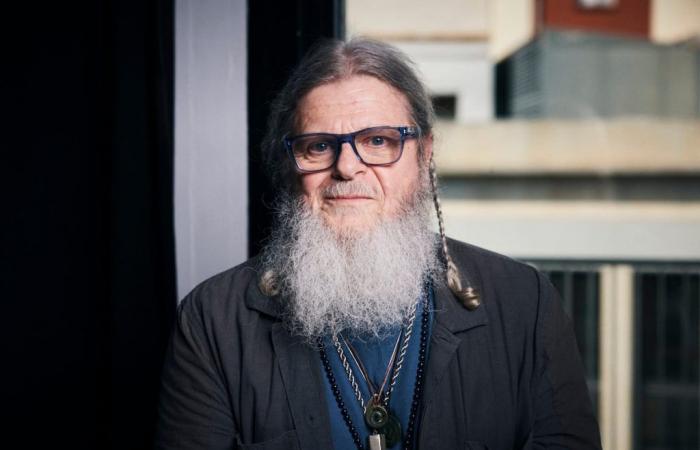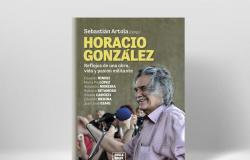
The search for identity is the constant that the award-winning musician Gustavo Santaolalla (El Palomar, Buenos Aires, Argentina, 72 years old) points out as the key to his work, although it is clear that inexhaustible curiosity is involved in this articulation. As we say goodbye after the interview, we hear how the teacher talks to his manager about an exotic mushroom while, presumably, showing him a photo that he has been looking for while spending several minutes on his cell phone. Before, without even entering the field of botany, he has listed a dizzying list of professional projects for 2024 and 2025, not only of a diverse nature, but superior to the complete discography of some artists. For now, the project that occupies Santaolalla at the time and coordinates in which our meeting takes place is Sound image of Madrid, which has been developing for weeks in the Spanish capital with students from the TAI University School of Arts. “It may be a title that is too ambitious,” she concedes, “but very interesting things are coming out. The reaction of the kids and the creativity they have put into the matter is wonderful.”
Santaolalla’s passion is noticeable in words and actions. One of his enthusiastic students is surprised by the degree of involvement of the Argentine, who “he thought would come to name” and has found him recording sounds at the Retiro one Sunday at five in the morning. What does it consist of Sound image of Madrid? “Murray Schafer is a Canadian who invented the concept of soundscape [paisaje sonoro]”explains the artist. “If you stand in the middle of a forest or a city in a contemplative attitude and begin to listen to its sounds, you begin to reinterpret them, to observe them like a musical score and to process that reality in a completely different way. The idea was to identify some places in Madrid that could give us sounds typical of the city.” Four short films with their respective musicians, directors and scriptwriters make up the project, each one in a setting: the Retiro Park, the Metro, the Mercado de la Cebada and the CentroCentro space, in the Palacio de Cibeles.
A visual symphony of Madrid, where the looping roar of the subway train can seem like the deep breathing of a sleeping leviathan and the Gran Vía station—with its turnstiles and wallets ticking in time—a haunted house. For Santaolalla, the project has a special resonance and the choice of the city has not been fortuitous: “For years I have felt a debt to my Spanish identity. My grandmother was Basque and my grandfather was Andalusian. I began to feel a need to connect more and in that process many times I ended up in Madrid. I made the determination to make my music connect not through distance, but by being present. “It is the first time I have spent so much time in Spain.”
“Identity has always been something very important to me,” he continues. “In Brokeback Mountain [2005]“In those silences, in those waits, there is the guitar of Atahualpa Yupanqui, the music with which I grew up.” Winner of two Oscars for his soundtracks for that film and Babel (2006), Gustavo Santaolalla’s path evokes another of the feature films he scored in that decade, Motorcycle Diaries (2004), the chronicle of how a young Che Guevara and his friend Alberto Granado developed their humanistic vision and notion of Latin American identity by touring the south of the continent on a motorcycle. “For me, the story of Motorcycle Diaries This is what happened to me with Arco Iris,” says the Argentine musician about his first band, founded in the sixties. “That time was transcendental for the history of humanity. The Beatles and Che Guevara coexisted, the first gurus arrived, experimentation with substances that altered states of consciousness, knowledge of Eastern philosophy spread… It was a very sweet moment. And in that search, this community that was the musical group was assembled.”
The band, pioneers of rock in Argentina, lived together like a commune hippy yogic, with a guru, Dana Winnycka, acting as spiritual guide. This year she was the subject of a documentary, Rainbow, music and philosophy. “We led an extremely disciplined, almost monastic life,” says Santaolalla. “In addition to being vegetarians and not taking alcohol or drugs, I fasted every Monday and led a celibate life for years, despite playing in a rock group and having all the pleasures in front of me, at my fingertips. I learned a lot of things, energy management, kundalini, tantra… When I read that Sting did that, I thought: I was already doing it when I was 20 years old! The musician, however, had been preparing to dedicate himself to the ecclesiastical since he was little, when he wanted to be a priest. “I had my first spiritual crisis at age 11, not because a priest did anything with me, but because of philosophical questions. They called my parents and everything. I wanted to be that or a doctor, and I think that what I have ended up doing has a little of both,” he reflects.
“Arco Iris was part of my spiritual search and we really expressed our spirituality in the purest way. We were not entangled in human minutiae. Our music was transcendental,” she asserts. “Then I had to continue down another path. Just as I tell you that I led an almost monastic life, then the pendulum swung the other way.” After that seminal project, Santaolalla formed the bands Soluna and Wet Picnic, and later began an outstanding career as a soloist and producer. Since the age of two thousand he has combined his work in the cinema with the band Bajofondo, still active. “Not only did I want to sing in my language instead of English, I also wanted to play in my language, that’s why I have always incorporated things from Latin American folklore. In Argentina I have been criticized a lot by intelligentsia of rock. ‘How are you going to play a chacarera rhythm with an electric guitar, that’s not rock!’, they said. But time has validated my proposal.”
Eau du snore
If there is an instrument that has marked the career of Gustavo Santaolalla, and of which he has become the most famous performer, it is the ronroco. It is an Andean instrument, belonging to the charango family, with five double strings. In 1998, Santaolalla based an entire album on it, Ronroco. The use of one of the album’s songs in the film The dilemma (1999), by Michael Mann, opened the doors of cinema to the Argentine: this is how it ended up sounding in a phenomenon like The Last of Us (the 2013 video game and the 2023 series) and sparking global interest in the utensil. “The album Ronroco “People have used it in births, in wakes, to meditate, to write…”, congratulates its author, who plans to commemorate his 25th birthday with a series of concerts around the world, a tour with a scheduled stop in Spain to 2025. Not only that: the album has been reissued on vinyl and Santaolalla also plans to sell signature instruments.
“Unfortunately, Argentina does not sound. It is a sound that is closer to crying than anything else”
“The ronrocos that I use are from a luthier named Chiquito Rodríguez, who passed away. There is no other manufacturer that makes those snorers,” he explains. “I have worked a lot with a luthier, Julio Magarino, to make instruments that in some way evoke his own. I am also making two different types of strings with Magma, from Argentina, very good too.” Smelling like an Andean instrument is another possibility that the anniversary will offer: “I have always been very interested in the topic of smell and for years I have had some ideas. That’s why I’m making a perfume with Julián Bedel, from Fueguia. We have gotten inside the ronroco and we have taken the molecule of the aromas of the instrument, of cedar, spruce pine and other components, with which we have created a perfume that has to do with the album in general, that places you in a introspective place.”
In addition to ethnomusicology, the study of tradition, fusion and its possibilities, Santaolalla, who has worked as a producer for decades with artists from a wide spectrum of genres (from Molotov, Maldita Vecindad or La Vela Puerca to Juanes and Julieta Venegas ), has also had a very prominent role in recent years in urban music, with collaborations with figures such as Wos or YSY A. Duki’s performance last weekend at the Santiago Bernabeu in Madrid featured incidental music composed by him . “I love working with young people, I really like it,” he says. “I always talk about how important the fruits of experience are, especially now that I have a lot of years, but I also believe in the fruits of inexperience. They are the ones that make you follow unsuspected paths. It’s the same thing that happens with errors, I work a lot with errors.”
It is reciprocated, because young people also like Santaolalla: the popularity of his music for The Last of Us has led to the average age of its fans dropping significantly. “There have always been people who have followed me and connected with my music, but I can’t explain the video game fans to you. There are people of 13, 14 or 15 years old who are fans. Do you know I’m in the second game? ”She asks with undisguised excitement. “They have put me as an avatar, if you reach a certain amount of points you can make me play the guitar. I am terrible at playing, but my son is very good and he has taught me that.” Santaolalla has started working on the soundtrack for the second season of the series and has the music ready for two other films that will be released this year, Norita and Pedro Paramo. He is also finalizing the production of a new Café Tacvba album, another solo album by Meme (a member of the Tacvba) and one by his band, Bajofondo.
The hyperactive moment of the Argentine musician has already left its mark in Spain with Sound image of Madrid, project that the TAI University School of Arts plans to present publicly in September. Asked about the sound of Javier Milei’s current Argentina, against whose cultural and educational policies, budget cuts and social climate he has publicly spoken out, Gustavo Santaolalla’s face darkens: “Unfortunately, Argentina does not sound. It is a sound that is closer to crying than anything else. After fighting for so many years, making great progress with equal marriage or the voluntary termination of pregnancy law, now it is like we are going back. They put me in prison when I was 15 or 16 for having long hair. When they knew I was an artist, they also took me to prison for nothing. I was saved from ending up in a ditch because I was a well-known musician. I have the privilege of being close to the Mothers of the Plaza de Mayo, the grandmothers and so many people who are now being mistreated. “It is a very sad moment for our country, very, very sad.”
You can follow ICON on Facebook, x, instagram,or subscribe here to the Newsletter.





